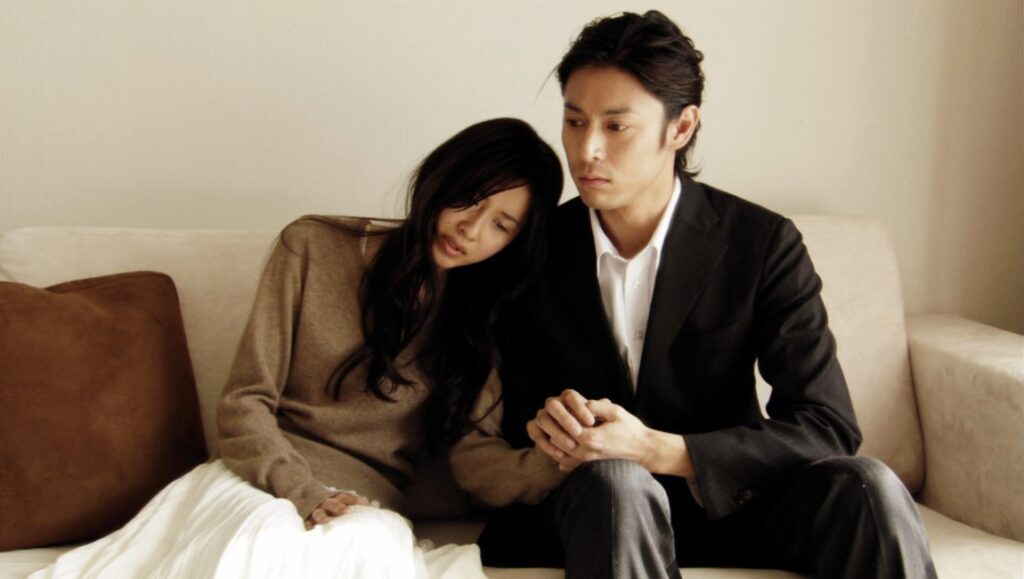Given his recent critically and commercially successful, Oscar-winning film Drive My Car, it was only a matter of time before Japanese arthouse director Ryusuke Hamaguchi became a “brand.” If American film culture is often too quick to anoint saviors and visionaries, Hamaguchi at least suggests the kind of idiosyncratic, genuinely personal vision of cinema that more often than not goes unnoticed in the mainstream. Another fringe benefit of this success: distributors eager to get their hands on anything with his name on it. Thus this belated release of Hamaguchi’s 2008 film school thesis project, Passion (which is actually his second feature). Hamaguchi famously studied under the great Kiyoshi Kurosawa, and this early work bears the most obvious influence of the master on his student. But Passion is no mere curiosity, nor something to be relegated to the bonus feature disc of a Blu-ray release. It’s a very good film in its own right, with Hamaguchi’s gift for compellingly complicated characters and philosophically-tinged conversations already on full display and fully formed.
Ostensibly a relationship drama set amongst a group of friends in their late-20s or early-30s, Hamaguchi constructs a series of dialogue-heavy set pieces that build in intensity until they seem on the verge of erupting. This verbal jousting is structured like action scenes, as characters jockey for dominance and hover around each other as if on a knife’s edge. The film begins with the group gathered for a birthday: Tomoya (Ryuta Okamoto) has just gotten engaged to Kaho (Aoba Kawai), and they are nervous to announce it to their friends. Also present are Takeshi (Kiyohiko Shibukawa), his very pregnant wife, and Kenichiro (Okabe Nao), the quietest member of the group. After the dinner ends, Tomoya, Takeshi, and Kenichiro decide to keep drinking and head over to Takako’s (Fusako Urabe) apartment. Takako and Kenichiro have a casual, on-again-off-again relationship — he has just recently helped her bury her cat — and it’s revealed that several years prior, Tomoya cheated on Kaho with Takako. To further complicate matters, Kenichiro is madly in love with Kaho and frets over whether to use his knowledge of Tomoya’s infidelity to drive a wedge between the recently engaged couple. Meanwhile, Takeshi, on the surface the most stable of the three men, seems to be having his own crisis of conscience, as he lashes out at his friends and attempts to woo Takako.
This is very much the stuff of melodrama on the one hand, or a rom-com on the other — depending on how one pitches the tone. But Hamaguchi opts for a third approach, treating these various encounters almost like a horror movie. Three major scenes dominate the film. In the first, Kaho addresses a group of students about one of their classmates who has committed suicide. She then launches into a long monologue about the nature of violence, becoming increasingly animated as she ultimately makes a case for forgiveness. As she puts it, the only way to fight violence is with non-violence, a point she illustrates by threatening to slap a student. It’s a charged sequence, a kind of philosophical treatise that also imprints itself on the remainder of the narrative — an aura of potential violence now hangs in the air in all of the film’s subsequent scenes. The second set piece involves Tomoya and Takeshi returning to Takako’s apartment some time after their initial visit and embarking on a vicious variation of Truth or Dare, each person challenging the other to answer questions with unvarnished candor. The trio volley back and forth, hurling insults and admitting dark truths about themselves before ending in a startling confrontation.
The third set piece is an epic, unbroken 12-minute take that finds Kenichiro finally admitting his feelings to Kaho, who in turn recounts a macabre story from her childhood involving a miraculous resurrection and the dissolution of her parent’s marriage. It’s a remarkable sequence, which begins as a static master shot of an industrial landscape and billowing smokestack, Kenichiro and Kaho’s voices emanating from somewhere offscreen. After several minutes, the camera slightly re-adjusts itself so that the two figures are suddenly visible; as they converse, their bodies move closer and closer to the camera. The two end up in a medium two-shot before the camera suddenly begins to dolly backward to keep pace with the duo. It’s a masterful bit of mise en scène, a seeming nod to Ozu that gradually turns into something much different. The film ultimately reaches a resolution of sorts, although one gathers that none of these characters are going to be the same after their various encounters and revelations.
The clearest indicator of Passion‘s minor origins is Hamaguchi’s use of lo-fi digital cameras. While his more recent work contains precise, careful frames, Passion indulges in plenty of handheld camerawork and jittery close-ups. The chunky, patchy digital blacks and blown-out whites make the film resemble Kurosawa’s own Bright Future, and interstitial shots of the city skyline at night bring to mind Gakuryu Ishii’s Angel Dust. Hamaguchi himself, meanwhile, has claimed John Cassavetes as a primary influence, and Passion certainly relates to the psychologically incisive works of that American independent master. But Passion is much more than the sum of these influences, or a simple game of spot-the-reference. It’s a major work from a major filmmaker, and though its U.S. theatrical arrival might be 15 years late, it provides some substantial contextualization for the artist’s early years.
Published as part of InRO Weekly — Volume 1, Issue 15.


Comments are closed.